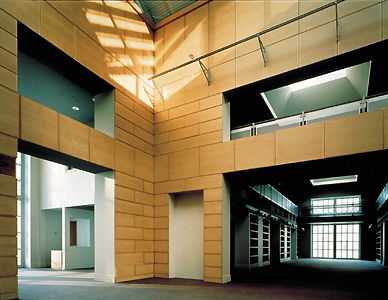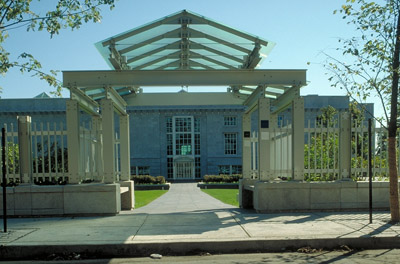Fred Thornton Hollingsworth, architect (born 8 January 1917 in England; died 10 April 2015 in North Vancouver, BC). Hollingsworth is recognized for his contributions towards West Coast Modernism, a distinctive architectural style (see Architecture). He served as president of the Architectural Institute of British Columbia and the Royal Architectural Institute of Canada.

Early Life
Born in England, Fred Hollingsworth emigrated with his family in 1929 to Marpole, Vancouver (see Immigration to Canada). He attended the Vancouver School of Art and initially pursued a career in commercial design. He worked with Boeing Aircraft during the Second World War.
Career
The quality of Fred Hollingsworth’s plans for his own house in North Vancouver (1946, extension 1957) were recognized by Charles E. Pratt of the distinguished local Modernist firm Sharp & Thompson, Berwick, Pratt (see Thompson, Berwick, Pratt and Partners). He articled with Sharp & Thompson, Berwick, Pratt (1946-51) designing a large number of inexpensive houses for the growing suburbs of Vancouver and North and West Vancouver. These houses combined the European rationalist and West Coast American streams of post-war Modern architecture. (See also Architecture.)
Hollingsworth was influenced by the organic principles of Frank Lloyd Wright, who offered him employment in 1951, and the formal and spatial innovation of Bernard Maybeck. Hollingsworth's early houses were modular post-and-beam structures atop concrete slab-on-grade containing a radiant heating system. They followed a generic type adjusted for individual clients and were denominated by Hollingsworth as "Neoteric." Over 50 were built in the Capilano subdivision in North Vancouver alone, the later variants exhibiting experimentation with standard pre-cut lumber and plywood.
During his apprenticeship with Sharp & Thompson, Berwick, Pratt, Hollingsworth evolved an increasingly creative personal form of expression, governed by ongoing preoccupation with the inter-relationship of building and site, use of natural materials, integration of form with structure and play of plane on plane, partly to attain an informal but client-tailored plan and appropriate spatial ambience. The desire for aesthetic independence led him to join William Birmingham as a design associate (1951-58). Together they privileged more craft elements, influenced not only by Frank Lloyd Wright but also by an appreciation for Japanese and West Coast architectural design. These traditions formed part of the discussions held by “The Intellects,” a group Hollingsworth formed with his friend Ron Thom and Bud Wood, Beans Justice, Arthur Erickson and Barry Downs, with whom he would form a partnership in 1963.
Projects and Clients
The characteristic Modernism Fred Hollingsworth evolved is exemplified in the “Red Feather” Community Chest and Council Building, Vancouver (1956, with William Birmingham, advisor Fred Lasserre; demolished), Imperial Inn, Victoria (1961-62) and Maltby House, West Vancouver (1962-63), awarded the Massey Gold Medal in 1964. The association with Barry Downs (1963-67) was highly productive and only ended because Hollingsworth wished to concentrate on domestic architecture.
Hollingsworth attracted more adventuresome clients such as Richard Trethewey (houses at Abbotsford and Haney, respectively 1960 and 1987), Steven Stewart (Provo, Utah, 1974) and Kenneth Malmgren (Burnaby, 1987-88). No less significantly his clients included Jack Moon (Vancouver, 1950, and Calgary, 1978), Tom McGrath (Bellevue, Washington 1966, additions 1969, and Seattle, 1984) and Peter and Marlena Fluckiger (White Rock, 1984 and 1997-98). Hollingsworth also completed innovative institutional architecture, notably the Berkeley Private Hospital, White Rock (1961) and the Law School Extension at the University of British Columbia (1962-63).
Legacy
Hollingsworth's reputation rests upon his distinctive domestic architecture, a strong example is the West Vancouver mansion built for the developer Nat Bosa (1991-93). He earned the highest professional honours, being elected president of the Architectural Institute of British Columbia (1971-72) and of the Royal Architectural Institute of Canada (1975-76).
Publications
- Living Spaces: The Architecture of Fred Thornton Hollingsworth (2005).
Honours and Awards
- Honorary Fellow, American Institute of Architects (1976).

 Share on Facebook
Share on Facebook Share on X
Share on X Share by Email
Share by Email Share on Google Classroom
Share on Google Classroom




